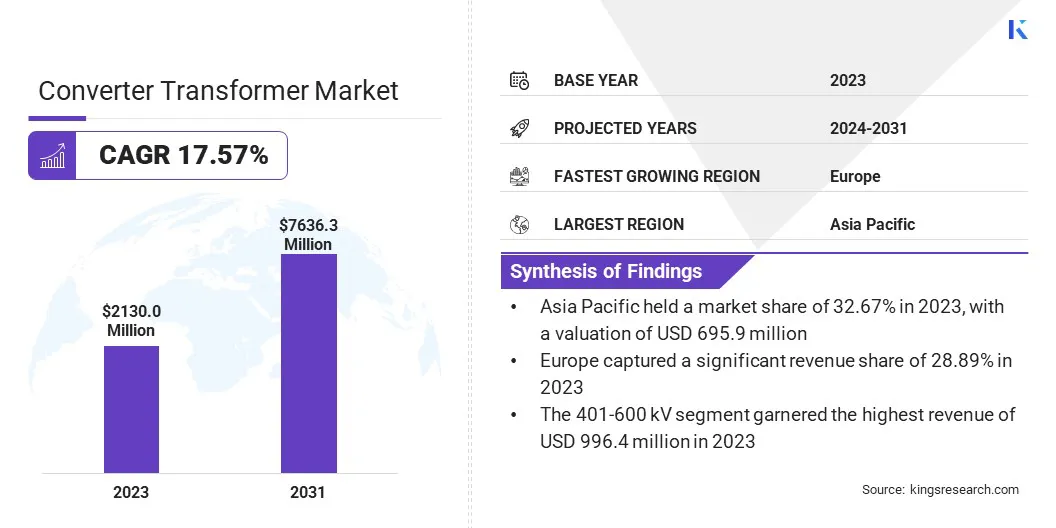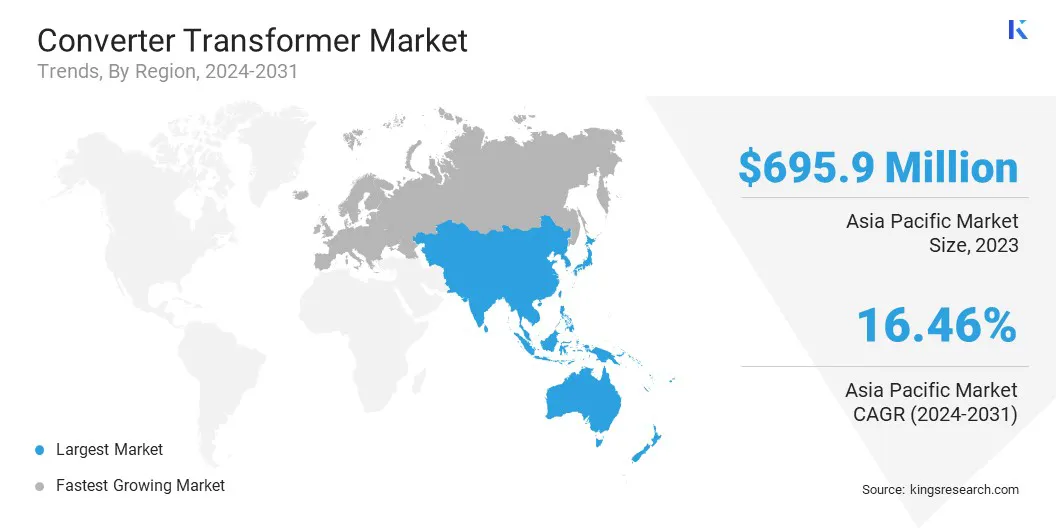The global Converter Transformer Market size was valued at USD 2,130.0 million in 2023 and is projected to grow from USD 2,459.0 million in 2024 to USD 7,636.3 million by 2031, exhibiting a CAGR of 17.57% during the forecast period. The market is witnessing robust growth driven by the increasing adoption of renewable energy sources.
Governments and energy regulatory bodies are incentivizing the integration of renewable energy into the grid, leading to a surge in demand for converter transformers.
In the scope of work, the report includes products offered by companies such as Siemens Energy, Schneider Electric, Mitsubishi Electric Corporation, Hitachi Energy Ltd., Emerson Electric Co., Bharat Heavy Electricals Limited, GE Grid Solutions, LLC, ALSTOM SA, ABB, HD HYUNDAI ELECTRIC CO., LTD., and others.
The proliferation of solar and wind energy projects, driven by increasing environmental consciousness and the pressing need to reduce carbon emissions, necessitates the installation of converter transformers to enable the efficient transmission of power. Furthermore, the ongoing electrification initiatives, especially in emerging economies, are fueling the demand for converter transformers.
Rapid urbanization and industrialization are creating the need for reliable and efficient electricity transmission infrastructure, presenting significant opportunities for market growth. Moreover, the expansion of smart grid projects and the integration of advanced technologies, such as HVDC (High Voltage Direct Current) systems, are bolstering market expansion.
The converter transformer market encompasses the manufacturing, distribution, and installation of specialized transformers designed for converting electrical energy between different voltage levels in power transmission and distribution systems.
These transformers play a critical role in facilitating the efficient transmission of electricity, particularly in high-voltage direct current (HVDC) transmission systems and renewable energy projects. The market includes various types of converter transformers, such as rectifier transformers, inverter transformers, and HVDC transformers, tailored to meet the specific requirements of diverse applications.
Key market participants include manufacturers, suppliers, and service providers who are addressing the growing demand for converter transformers across various industries and regions.

Analyst’s Review
The converter transformer market is poised to witness substantial growth in the forthcoming years, mainly propelled by factors such as increasing demand for renewable energy integration, electrification initiatives, and advancements in transmission technologies.
Additionally, the rising need for efficient power transmission and distribution systems to meet the growing energy demand is also expected to drive the market growth. Moreover, government initiatives to upgrade existing power infrastructure and the expansion of smart grids are further anticipated to boost the demand for converter transformers.
The integration of renewable energy sources, mainly solar and wind power, into the global energy mix is prompting significant changes in power transmission and distribution systems. As renewable energy generation trends toward intermittency and potential fluctuations, there is a growing demand for efficient grid integration solutions.
Furthermore, the demand for high voltage direct current (HVDC) transmission systems is increasing, mainly attributed to the need for long-distance energy transportation with minimal power loss. HVDC technology offers distinct advantages for transmitting electricity over long distances, and converter transformers serve as essential components of HVDC systems.
The rising adoption of HVDC transmission is boosting the demand for converter transformers worldwide.
Moreover, as the focus is shifting toward smart grid development, advanced power electronics are becoming integral for efficient power management and control. Converter transformers are well-suited for integration within smart grids, enabling real-time monitoring and optimization of power flow.
By leveraging converter transformers within smart grid infrastructure, utilities are enhancing grid stability, reliability, and efficiency, thereby facilitating the seamless integration of renewable energy sources and supporting the expansion of HVDC transmission networks. This interconnectedness emphasizes the critical role of converter transformers in shaping the global energy landscape.
However, the converter transformer market faces several challenges, primarily due to high initial investment costs and technical complexity. While converter transformers offer superior performance, their higher upfront costs deter some grid operators and utilities from adopting them.
Moreover, integrating these transformers into existing grids demands meticulous planning and technical expertise to ensure compatibility and seamless operation. Key players are emphasizing technological integration to overcome these challenges through strategic investment decisions and collaborative efforts.
Notable shift toward modular designs, which offer enhanced flexibility, scalability, and maintenance ease, is boosting market expansion. Furthermore, the demand for compact converter transformers is increasing, propelled by urban space constraints and the need for high power density.
Multi-terminal configurations are gaining significant traction, as they facilitate power transmission across disparate grids, particularly in the integration of renewable energy sources.
Additionally, the rise of digitalization and automation in control systems is enhancing operational efficiency and reliability through real-time monitoring and automated operation. Additionally, manufacturers are emphasizing sustainability, employing eco-friendly materials, and designing products with minimized environmental impact throughout their lifecycle.
Segmentation Analysis
The global market is segmented based on capacity, application, and geography.
By Capacity
Based on capacity, the market is categorized into 201-400 kV, 401-600 kV, and 601-800 kV. The 401-600 kV segment led the converter transformer market in 2023, reaching a valuation of USD 996.4 million. This segment caters to high-voltage transmission projects, that are essential for long-distance power transmission with minimal losses.
The growing demand for such projects, boosted by the need to connect remote renewable energy sources to urban centers and industrial hubs, is fueling the demand for converter transformers in this voltage range.
Additionally, grid modernization initiatives, particularly in developed economies, are prioritizing the deployment of high-voltage transmission systems to enhance grid reliability and efficiency. Furthermore, technological advancements enabling higher voltage capabilities and improved converter transformer performance are contributing to the growth of the segment.
By Application
Based on application, the market is divided into wind farms, oil & gas, and grid connections. The grid connections segment captured the largest market share of 41.90% in 2023. The increasing integration of renewable energy sources into the grid is leading to an increase in the demand for converter transformers for grid connections.
As countries worldwide are striving to meet renewable energy targets and reduce carbon emissions, there is a growing need to connect large-scale wind and solar farms to the grid efficiently.
Additionally, ongoing grid modernization initiatives, particularly in developed economies, prioritize the upgrading and expansion of transmission networks, thereby boosting the demand for converter transformers for grid connections.
Moreover, the electrification of remote areas and the expansion of urban infrastructure contribute to increased investments in grid connectivity projects, thereby supporting the growth of the grid connections segment.
Based on region, the global market is classified into North America, Europe, Asia-Pacific, MEA, and Latin America.

Asia-Pacific Converter Transformer Market share stood around 32.67% in 2023 in the global market, with a valuation of USD 695.9 million. Rapid economic growth and urbanization have heightened the demand for a continuous energy supply.
Additionally, government initiatives aimed at smart grid development are driving the demand for converter transformers. Booming economies and burgeoning urban centers are prompting the need for substantial investments in expanding and modernizing power grids, leading to a surge in demand for converter transformers.
For instance, China's Belt and Road Initiative aims to enhance connectivity and infrastructure development across Asia-Pacific, fostering investments in power infrastructure and creating opportunities for converter transformer suppliers.
Additionally, increasing focus on mini-grid and rural electrification projects presents a potential opportunity for converter transformers tailored specifically for smaller-scale applications. These projects are aimed at expanding electricity access to remote areas and underserved communities, requiring cost-effective and efficient converter transformers suitable for mini-grid deployments.
For instance, India's Saubhagya scheme aims to electrify all households in rural areas, thereby increasing the demand for compact and affordable converter transformers.
Europe captured a significant revenue share of 28.89% in 2023. Several factors such as stringent emission reduction targets and an interconnected grid system is supporting regional market expansion. With ambitious goals for reducing greenhouse gas emissions,
European countries are prioritizing technologies that contribute to higher energy efficiency and lower environmental impact. Converter transformers, renowned for their efficiency, are aligned seamlessly with these objectives, thereby driving their widespread adoption across the continent.
For instance, Germany's Energiewende initiative aims to transition to a low-carbon energy system, emphasizing the need for advanced grid technologies, such as converter transformers, to facilitate the integration of renewable energy sources.
Furthermore, Europe's interconnected grid system presents lucrative opportunities for regional market growth. For instance, projects such as the North Sea Wind Power Hub are focused on leveraging offshore wind energy from multiple European countries and distributing it across the continent via interconnected grids, highlighting the significance of converter transformers in cross-border renewable energy integration.
Competitive Landscape
The global converter transformer market report will provide valuable insight with an emphasis on the fragmented nature of the industry. Prominent players are focusing on several key business strategies such as partnerships, mergers and acquisitions, product innovations, and joint ventures to expand their product portfolio and increase their market shares across different regions.
Companies are implementing impactful strategic initiatives, such as expanding services, investing in research and development (R&D), establishing new service delivery centers, and optimizing their service delivery processes, which are likely to create new opportunities for market growth.
List of Key Companies in Converter Transformer Market
- Siemens Energy
- Schneider Electric
- Mitsubishi Electric Corporation
- Hitachi Energy Ltd.
- Emerson Electric Co.
- Bharat Heavy Electricals Limited
- GE Grid Solutions, LLC
- ALSTOM SA
- ABB
- HD HYUNDAI ELECTRIC CO., LTD.
Key Industry Developments
- December 2023 (Acquisition): Blackstone acquired Power Grid Components, Inc. (PGC), from Shorehill Capital LLC. PGC is renowned for its expertise in designing and producing a diverse array of vital components utilized in electrical substations. These components play a pivotal role in ensuring protection, monitoring, and safety within electrical substations, which are integral parts of the electrical grid responsible for overseeing power flows and converting electricity into varying voltages.
The Global Converter Transformer Market is Segmented as:
By Capacity
- 201-400 kV
- 401-600 kV
- 601-800 kV
By Application
- Wind Farms
- Oil & Gas
- Grid Connections
By Region
- North America
- Europe
- France
- U.K.
- Spain
- Germany
- Italy
- Russia
- Rest of Europe
- Asia-Pacific
- China
- Japan
- India
- South Korea
- Rest of Asia-Pacific
- Middle East & Africa
- GCC
- North Africa
- South Africa
- Rest of Middle East & Africa
- Latin America
- Brazil
- Argentina
- Rest of Latin America


